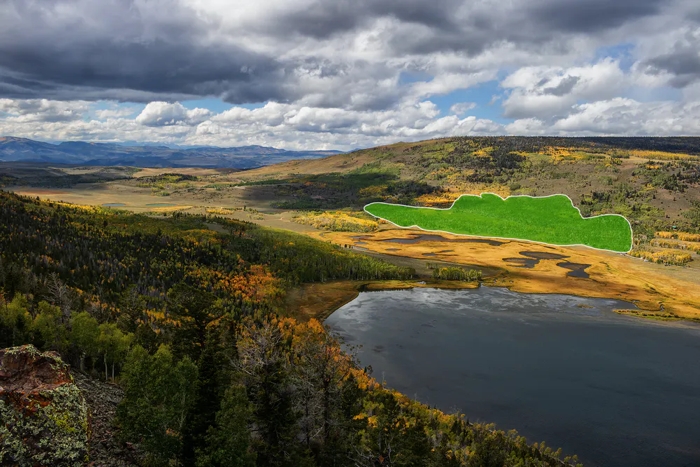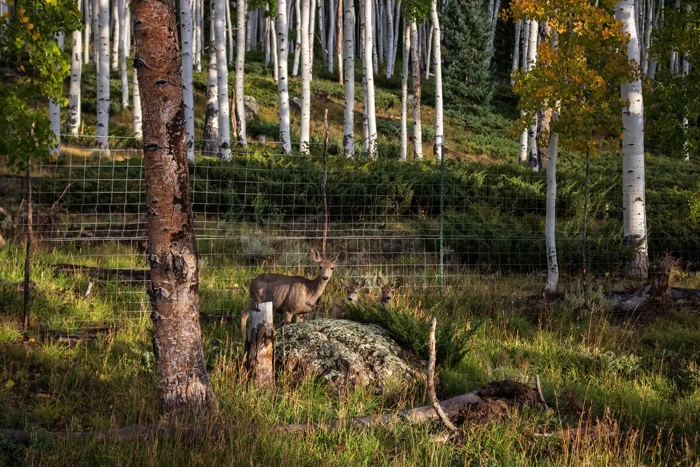In the Wasatch Mountains of the western United States, on the slopes above a spring-fed lake, lives a giant organism that provides an entire ecosystem that plants and animals have relied on for thousands of years.
Found in Utah, Maine, Pando is a 106-acre stand of quivering mill clones.
Although it looks like a forest of individual trees with striking white bark and tiny leaves that sway with the slightest breeze, pandu (Latin for “I spread”) is actually 47,000 genetically identical stems that grow from a root network. They come together.
This genetic individual weighs only about 6000 tons. It is the largest single organism on Earth by mass.
 Aerial view of Pandu, with fish lake in foreground. (Lance Audit/Friends of Pando)
Aerial view of Pandu, with fish lake in foreground. (Lance Audit/Friends of Pando)
Aspen trees tend to form clonal stands elsewhere, but what makes Pando interesting is its sheer size. Most clonal aspen stands in North America are much smaller, averaging only 3 acres in the western United States.
Pandu has been around for thousands of years, potentially up to 14,000 years, despite most stems only living around 130 years. Its longevity and remoteness mean a whole ecosystem of 68 plant species and many animals thrive and support under its shadow.
This entire ecosystem relies on aspen staying healthy and upright. But, although the pandu is protected by the US National Forest Service and is not in danger of being cut down, it is in danger of disappearing due to several other factors.
Deer eat the youngest trees
Indiscriminate grazing of deer and deer is one of the biggest concerns. Wolves and wolves once controlled their numbers, but packs are now much larger due to the loss of these predators.
Elk and deer also tend to congregate in Pandu because the protection the forest receives means they are not at risk of being hunted there.
 Deer eating pandu stem. (Lance Audit/Friends of Pando)
Deer eating pandu stem. (Lance Audit/Friends of Pando)
As older trees die or fall, light reaches the forest floor, which stimulates new clonal stems to begin growing, but when these animals eat the tops of the newly formed stems, they die. This means that there is little growth in large parts of Pandu.
The exception is an area that was fenced off decades ago to remove dying trees. This enclosed area has excluded deer and deer and has seen the successful regeneration of new, densely grown clonal stems called the “Bamboo Garden”.
Diseases and climate change
Older stems in pandu also suffer from at least three diseases: sooty bark canker, leaf spot, and Konk’s fungal disease.
While plant diseases have developed and thrived in aspen stands for thousands of years, given the lack of new growth and a list of other pressures on the giant clonal, it is unclear what long-term impact it might have on the ecosystem. .
The fastest growing threat is climate change. Pandu emerged after the last ice age had passed and since then has dealt with a largely stable climate.
 Pandu has survived disease, hunting and colonization. (Lance Audit/Friends of Pando)
Pandu has survived disease, hunting and colonization. (Lance Audit/Friends of Pando)
It certainly lives in an alpine region surrounded by desert, which means it’s no stranger to hot temperatures or drought. But climate change threatens the size and lifespan of the tree as well as the entire ecosystem that hosts it.
Although no scientific studies have focused specifically on pandu, aspen stands are struggling with pressures associated with climate change, such as reduced water supplies and warmer weather earlier in the year, making it harder for trees to form new leaves. does, which leads to reduction. in cover
With more competition for ever-decreasing water resources (fish ponds are close to remote tree root systems), summer temperatures are expected to continue at record highs, and the risk of more intense wildfires, Pando is sure to struggle. will be faced Adapt to these rapidly changing conditions by maintaining your size.
The next 14,000 years
However, Pandu is resilient and has already survived rapid environmental changes, especially when European settlers began to settle in the area in the 19th century or after the advent of recreational activities in the 20th century. It has already battled disease, fire and grazing and remains the world’s largest scientifically documented creature.
Despite any cause for concern, there is hope as scientists help us uncover the secrets of the pandu’s resilience, while conservation groups and the US Forest Service work to protect the tree and its associated ecosystem. . And a group called Friends of Pando plans to make the tree available to almost everyone through 360-degree footage.
One summer, while visiting family in Utah, I took the opportunity to visit Pando. I spent two wonderful days walking under the tall mature stems that swayed and swayed in the gentle breeze, between the thick new growth in the “bamboo garden” and even in the attractive lawns that punctuate parts of the enclosed center.
I marveled at the wildflowers and other plants growing under the shaded canopy, and was able to enjoy seeing pollinators, birds, foxes, zebras, and deer all using part of the ecosystem created by Pandu.
These are the moments that remind us that we have plants, animals and ecosystems worth protecting. At Pando, we have a rare chance to protect all three.![]()
Richard Elton Walton, Postdoctoral Research Associate in Biology, University of Newcastle.
This article from The Conversation is republished under a Creative Commons license. Read the original article.
A previous version of this article was published in November 2021.
#Scientists #largest #creature #earth #slowly #eaten